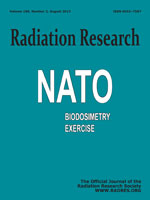The focus of the study is an intercomparison of laboratories' dose-assessment performances using the γ-H2AX foci assay as a diagnostic triage tool for rapid individual radiation dose assessment. Homogenously X-irradiated (240 kVp, 1 Gy/min) blood samples for establishing calibration data (0.25–4 Gy) as well as blinded test samples (0.1–6.4 Gy) were incubated at 37°C for 2 and 24 h (repair time) and sent to the participants. The foci assay was performed according to protocols individually established in participating laboratories and therefore varied. The time taken to report dose estimates was documented for each laboratory. Additional information concerning laboratory organization/characteristics as well as assay performance was collected. The mean absolute difference (MAD) of estimated doses relative to the actual doses was calculated and radiation doses were merged into four triage categories reflecting clinical relevance to calculate accuracy, sensitivity and specificity. First γ-H2AX based dose estimates were reported 7 h after sample receipt. Estimates were similarly accurate for 2 and 24 h repair times, providing scope for its use in the early phase of a radiation exposure incident. Equal accuracy was achieved by scoring 20, 30, 40 or 50 cells per sample. However, MAD values of 0.5–0.7 Gy and 1.3–1.7 Gy divided the data sets into two groups, driven mainly by the considerable differences in foci yields between calibration and blind samples. Foci yields also varied dramatically between laboratories, highlighting reproducibility issues as an important caveat of the foci assay. Nonetheless, foci counts could distinguish high- and low-dose samples in all data sets and binary dose categories of clinical significance could be discriminated with satisfactory accuracy (mean 84%, ±0.03 SEM). Overall, the results suggest that the γ-H2AX assay is a useful tool for rapidly screening individuals for significant exposures that occurred up to at least 24 h earlier, and may help to prioritize cytogenetic dosimetry follow-up.
How to translate text using browser tools
24 July 2013
Laboratory Intercomparison on the γ-H2AX Foci Assay
K. Rothkamm,
S. Horn,
H. Scherthan,
U. Rößler,
A. De Amicis,
S. Barnard,
Ulrike Kulka,
F. Lista,
V. Meineke,
H. Braselmann,
C. Beinke,
M. Abend
ACCESS THE FULL ARTICLE

Radiation Research
Vol. 180 • No. 2
August 2013
Vol. 180 • No. 2
August 2013




